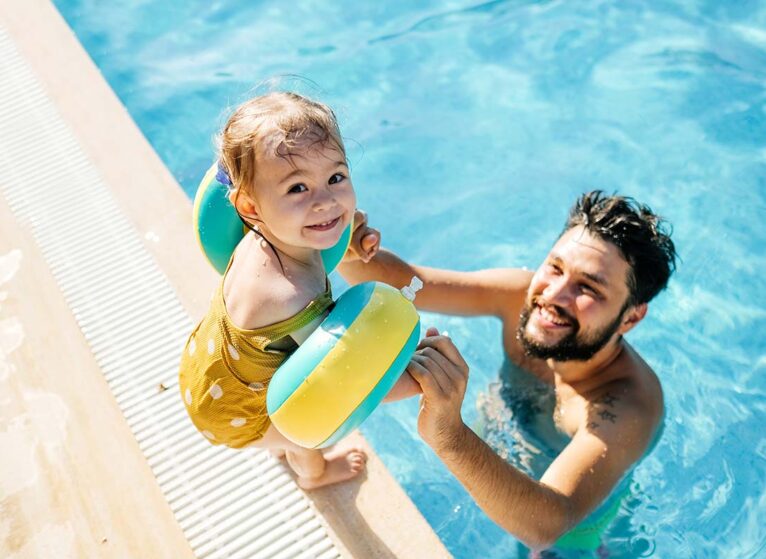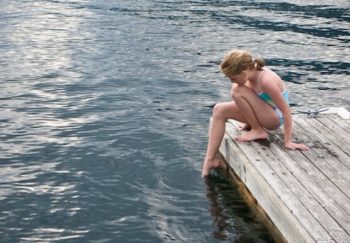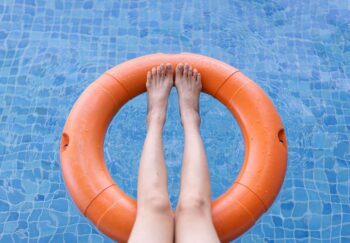
If you want to know how to avoid drowning, whatever water you’re in, Leza Sisley and Rita Krenz are the right people to ask. They’ve seen it all.
Sisley works in prehospital education at UVA Health, is a firefighter paramedic with the Wintergreen Fire department and a lifelong member of the Lake Monticello Fire and Water Rescue Squad. Krenz serves the UVA Health emergency room as a paramedic. She also served 25 years on the Scottsville Volunteer Rescue Squad, which included water rescue. They’ve seen white water rescues, pool drownings, boaters lost on rivers, friends jumping off dams, and kids getting caught in hydraulics. Both have been in the UVA Health emergency room more times than they can count.
When I asked them to tell me the biggest mistakes people make in water, they were eager to share.
“Water is the most deadly force on earth,” Sisley says. “It goes where it wants.” When we misjudge the power of water is when we make the worst mistakes.
Mistake #1: Drinking Alcohol
“It’s the #1 cause of most rescue scenarios,” Sisley says. “You’re 10 feet tall and bulletproof when you’re drunk. You jump off of things you normally wouldn’t jump off of. You dive into things you normally wouldn’t dive into.”
She and Krenz have seen dozens of alcohol-related situations on boats, tubes and even river shores.
When you drink, your risk of drowning intensifies because:
- Your reaction time slows. “If you’re drunk, when you slip out of your tube, your friends are also drunk, and it takes a while for them to notice you haven’t come up for air,” says Sisley.
- It’s easier to get lost. “A lot of rescue calls I’ve gone on – we found people miles upstream, completely delirious under the influence of alcohol with no idea where they are,” Krenz explains.
- Dehydration happens. “Combined with July heat in Virginia, you’re drinking alcohol and the river is low and moving slow,” Sisley says. “You anticipate being on the river for 4 hours and it ends up being 8. You’re dehydrating yourself with alcohol; maybe you don’t pack enough water.”
- You misjudge the heat, upping your risk for hyperthermia and sun poisoning. “It’s very easy to underestimate the heat when you feel cool due to the water, and you’re drinking cold beer or Gatorade,” Sisley says. “But you don’t realize you’re in the sun on reflecting water in a tube for 6 hours. You’re sweating more than you’re taking in, and your body’s not able to get rid of the heat as fast as you’re accumulating it.”
Sisley knows people enjoy lazy river trips. “It’s fun – I’ve consumed beers on the river – before joining EMS. I make better decisions now that I’ve seen others’ mistakes. They’re easy to make,” she says.
Hot Tip
Going out on a tube, kayak or canoe? Let someone know when and where you expect to get to your destination. There’s no way to help you if people don’t know you’re lost or where to look!
Remember, she says: When you’re out on water and face an emergency, lack of a cell signal can prevent you from calling for help. Shallow water can make it hard for rescue boats to find you. In these cases, avoiding an emergency is your best bet for staying safe.
Mistake #2: Forgetting Water Facts During a Flood
Sisley recalls seeing news coverage of a flood in Oklahoma on TV. She watched in horror as two firefighters in swift-moving flood water tried to rescue a guy clinging to a tree.
“Neither had any protective clothing on. Neither one of them had a flotation device. They’re in a good foot of floodwater, you can’t see through it, it’s brown, their engine is in the water, and it’s a disaster waiting to happen.” She notes that it only takes 6 inches of water to float a car.
People also forget about bacteria in floodwaters. “It’s easy for people to let their kids wade up to their knees,” Krenz says. “But you don’t know what’s in it as far as bacteria, whether the sewer systems have overflowed or not. Or what is happening underneath.”
She recalls that, after a hurricane in South Carolina, rescuers found an 8-year-old child in a culvert pipe. “It looks like the water is smooth on the surface. But if you stand in front of that culvert, and all that water’s shooting into that pipe, it’s enough to pull you off of your feet, and then you get stuck, and there’s no way you can get out.” She shakes her head. “I don’t think people think about it – looks calm on the top, so you assume that it’s safe.”
Mistake #3: A Slight Slip in Supervision
Krenz informs me that her rescue crew responds to at least one drowning or near-drowning a season.
The reason these drownings happen? “I think the vast majority of children in this country are well-supervised,” she says. “It just happens really fast. The children we see were in supervised situations, and there’s been a momentary lapse.”
What is Drowning vs. Near-Drowning?
- If you drown and stay dead, it’s a drowning.
- If you drown and survive the first 24 hours and then die, it’s a near drowning
The typical situation she’s come across, Krenz says, is that “mom and dad are inside, and they’re milling around. They think everybody else is watching. A kid jumps in who can’t swim, and in 2 to 3 minutes, he’s unconscious under the water. It’s barely enough time to get a burger off the grill.”
The same thing can happen at a public pool with a lifeguard. “It only takes a couple minutes. So, if the lifeguard’s down at one end dealing with something, and it’s a couple minutes until he’s back scanning again, and junior over here is struggling – there’s not enough time to fish him out.”
Drowning is Easy to Miss
Sisley points out the challenge that exists for parents or lifeguards in pools with lots of children.
“We all think if someone’s drowning, it’s going to be a loud dramatic event. But it’s not at all obvious.” When a child starts to drown, they sink quietly.
In a busy pool, a lifeguard or parent can scan a surface crowded with heads and “you may not see there’s a body under the water at all.”
Mistake #4: False Faith in Floaties
Krenz’s biggest pet peeve is floaties, also known as water wings. They give parents and kids a false sense of security.
“Picture a 5-year-old child, unconscious with floaties,” she says, passionately. “Their arms go up because of the floaties and are the most elevated part of the body, not the child’s head.”
Flotation Vest Regulations
Get details on:
- Flotation device safety and fit
- Different types of PFDs
Her advice to parents: If you’re going to be near water in a situation where your kid can’t swim, put them in a personal flotation device (PFD).
Have a stubborn kid resisting the PFD? Parents can choose life jackets integrated into a child’s swimsuit. “Your goal is to keep the head above water,” Krenz says. “Anything that does that is better than wings.”
Mistake #5: Floating Without Flotation Devices
Krenz and Sisley have several anecdotes of people who have taken small canoes or boats on little ponds like Sherando Lake or Mint Springs without flotation devices. These seemingly calm waters hide dangerously “murky depths.” Ignorant boaters will tip over, sink, and drown.
And Krenz explains that, “you can have the best lifeguards in the world, but once your head’s under water in that kind of water, no one can see you.”
Those incidents lead to recovery, not rescue, operations – searches that take hours, as divers blindly feel around at the bottom for the body.
“People don’t think about capsizing when they’re out fishing like that,” Sisley says. “One of the biggest mistakes is not having a flotation device for everyone.”
Mistake #6: Flotation Vests That Don’t Fit
When a life jacket is too loose, it doesn’t work.
“You see a person submerged, and the jacket comes up,” Sisley explains. “In those full-body ones people ride a jet ski in, if you pass out, you’re face down. Sure, you’ll float, but it’s not going to hold your airway open for you.”
This is why child life jackets have straps that go between their legs. This mechanism “holds the PFD down. And you want one that will actually flip them over.” Some kayaking PFDs, for instance, have material that will turn you face up if you pass out.
These may be the more expensive models of flotation devices, Leza and Rita acknowledge. But they’re worth it, Sisley says. “You get what you pay for with flotation devices just like you do everything else.”
Mistake #7: Not Knowing How to Swim
The simplest, most straightforward safety measure to take?
“Teach your kids how to swim,” Krenz says. “I was competent in the water at 3 years of age. It’s totally possible. That’s the way to go.”
Mistake #8: Jumping & Diving
There’s a number of ways to hurt yourself when jumping into a body of water – a dam, off a bridge, into a lake or even a pool.
Too-Shallow Water
You can’t tell how deep it is and you hit the ground or some other obstacle in the water, causing spinal injuries.
Hitting the Water
“If you misjudge your flip and land flat on your back or your belly from a height, that’s a significant cervical or brain injury for sure,” Sisley says. “At 50 feet, that’s like landing on concrete. At 100 feet, it’s a fatality every time.”
Even in a pool, hitting the water can have consequences. Landing flat on your back on the surface of the water can knock the wind out of you. Stunned and swallowing water, a child in this situation can end up unable to “stop coughing, spiking a fever and getting a wicked aspiration pneumonia from breathing in water.”
Hitting the Side of the Pool
Even in swimming pools, there’s risks. People can injure their cervical spine quite badly when miscalculating a dive, Krenz says.
Mistake #9: A Lack of Swift Water Savvy
“Swift water doesn’t always look like swift water,” Sisley says. “Underneath the calm surface, the water’s moving really quickly. The James at 8 feet looks great, and you think, ‘I can swim in that!’”
Rocks on the river’s bottom pose the biggest threat. If you try to stand, your feet can become wedged in them, and your body flips forward.
The scary thing is that this situation has happened to people with safety gear, experience and with others watching. Sisley remembers one especially tragic example.
“There was a kid, very experienced, wearing all the safety gear he could in white water. He rolled over, came out of his kayak, put his feet down, and his foot got wedged between two rocks. He was trying to pull up, to sit up, to keep his head above water. Nobody knew what to do. After two minutes of doing a sit-up against 600 pounds of water, he couldn’t do it anymore.” He drowned in front of a restaurant full of people.
Sisley has a personal story, too. “A friend of mine friend drowned 2 years ago – one of the best whitewater kayakers I’ve known. The force of water – even if it doesn’t look that strong – against your body – you don’t stand a chance.”
What to Do in Swift Water
So if trying to stand up in fast water could get you caught in rocks, what should one do to avoid getting swept away?
Krenz and Sisley describe the proper way to “self-rescue”:
- Aim your body toward the shore, feet first
- Angle your body so the water will push you to one side or the other
- Cross your feet
- Put your arms on your chest
“This isn't intuitive,” Krenz recognizes. “It’s hard to do in a panic-ridden situation. You don't practice this as a normal human being. People are going to try to swim or try to stand up.”
Mistake #10: Not Knowing How to Rescue Others
Often people try to rescue drowning people or pets and get themselves into trouble.
The problem? In the water, a panicking adult will try to stand on your head.
Staying Safe
Find more tips for avoiding accidents and injury.
“It’s the brain’s reflex to get to the surface,” she explains. “They will try to climb up you to get high. Or get on your kayak and tip you over.”
The right thing to do? “Reach or throw, don’t go,” Krenz says. “Throw a buoy or skimmer to pull someone in. Throw a rope or bag. The last thing you want to do as a rescuer is get in the water.”
Which is exactly how I felt after this conversation – like the last thing I wanted to do was get in the water. Ever.
But a few days later, describing some of the things I’d learned about surviving swift water and floods to friends, I have to admit – I felt, not fear, but a sense of confidence.
Rita says, in emergencies, “the people who survive are the ones who have a plan.” With the right information, skills and equipment, you can approach your next day at the pool or river with a sense of fun and adventure.



Had a young friend drown from Shallow Water Blackout. Outstanding swimmer, as most seem to be who drown from this silent killer. While rare, it might be worth educating people about this as well since most strong swimmers are unaware of its existence. I had never heard of it though I can see exactly how it can happen. Being a former swimmer, it is not difficult to envision pushing oneself to this point without recognizing the danger. Just a suggestion.
I agree. After reading this article I don’t want take a shower let alone go swimming. 😳
I hear all the time about someone jumping into a lake and not resurfacing caused by people gasping when they hit the water. Very common